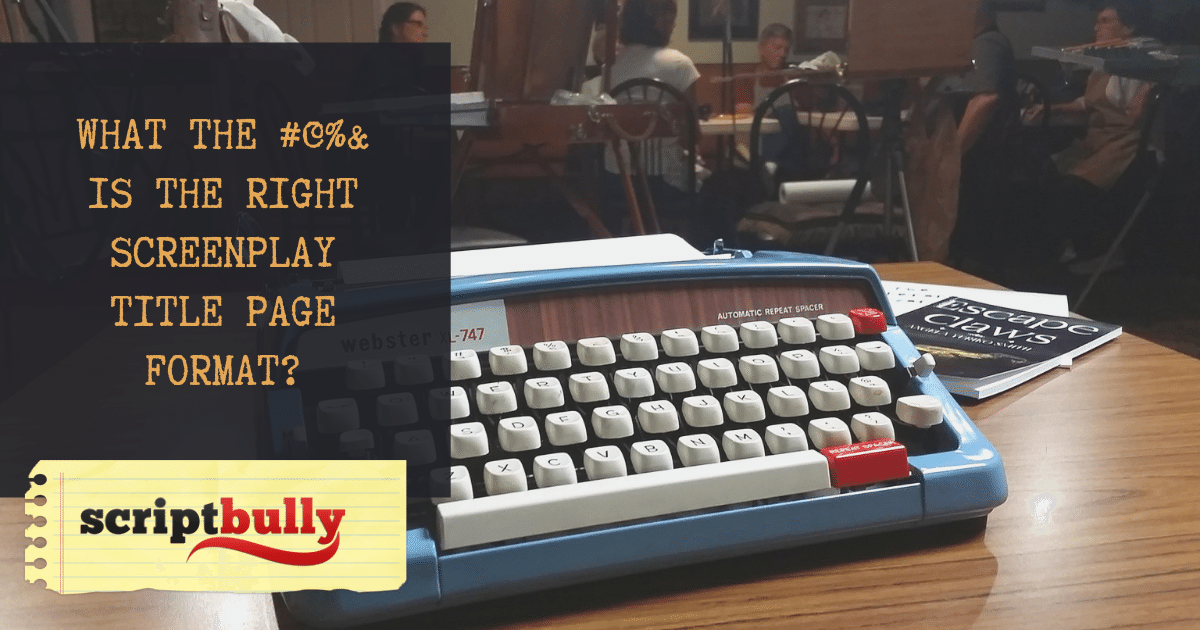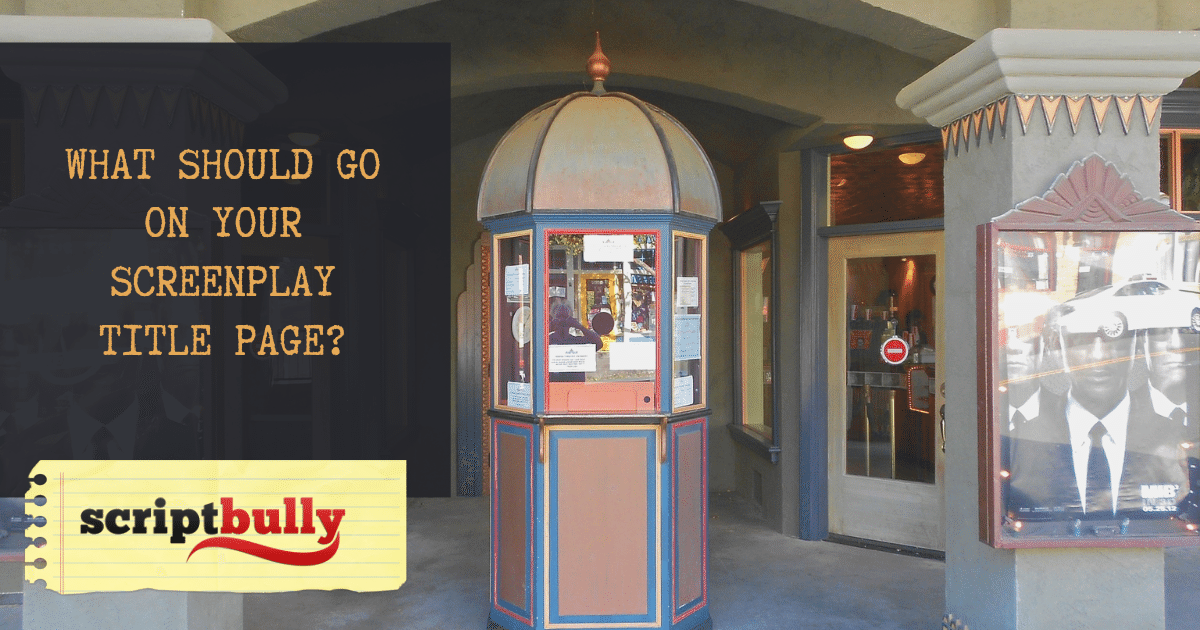I don’t think there’s any BIGGER source of stress for screenwriters – aside from having to watch a Michael Bay movie (again) – than screenwriting format.
And it’s understandable, script formatting looks like some foreign, arcane language. (Something Indiana Jones would use to find the Ark of the Convenant.)
And nothing SCREAMS “I’m an amateur” quicker than ill-advised screenplay format. (Especially that prickly form known as TV Script Format.)
So with that, here are some answers to the TEN most FAQ around screenwriting format. (Just remember the MOST important formatting strategy is a kick-ass screenplay.)
What You Need to Know About Screenwriting Format
FAQ #1: Won’t screenwriting software, such as Final Draft, handle most of my script software needs?
Yes and no.
Software WILL handle the mind-numbingly boring task of handling your margins and spacing. (Trust me, you don’t want to do this.)
But other more nuanced decisions like whether a scene is INT. or an EXT. – as denoted in a scene’s slugline. (Example: INT. STARBUCKS – DAY.) Or how to properly format things like montages, flashbacks, phone calls…require a more deft hand.
FAQ #2: I know INT. means interior and EXT. means exterior. But what about things like cars or stadiums or patios?
So…it helps to remember what this screenwriting format direction is for. It lets the crew make a PLAN for which scenes will require indoor or outdoor lighting.
This is why a car, even a convertible, is ALWAYS an INT. And a stadium or a restaurant patio is an EXT. It’s a matter of lighting – not so much geography.
This is why a car, even a convertible, is ALWAYS an INT. And a stadium or a restaurant patio is an EXT. It’s a matter of lighting – not so much geography.
One additional thing to remember, if you’re writing a low-budget script – and as a newbie you probably should be – keep your number of locations to a minimum. (They get expensive.)
FAQ #3: How specific do I have to get in the slugline? (Can I just put Starbucks in the slug, or do I need to be more detailed.)
It really depends on the scene. If your scene is set at Yankee Stadium, and your big action sequence takes place between shortstop and third base…then we’ll need more information than just EXT. YANKEE STADIUM – DAY.
What you want to AVOID is needless slugline description. (It bores script readers…and when they get bored they skip.)
If there’s ONE PLACE where you can go really crazy with your slugline description it would be that opening, table-setting image of yoru script. You know that…
EXT. SPAIN – SANTIAGO DE COMPOSTELA – CATEHDRAL ENTRANCE – DAY.
FAQ #4: How do I handle close ups? (Or any other camera movement?)
First off, the way NOT to handle is to do something like WE PULL BACK TO REVEAL or WE MOVE IN. (Don’t do this. Please.)
Instead the better way to do a close up is something like: CLOSE ON DARTH MAUL or CLOSE – DARTH MAUL’S SPIKY HEAD.
Just remember this is a TRUE close up. (Not just a medium shot, where the camera takes in the subject from the waist up.)
If you wanna just do a med. shot then simply refer to the character in the description and the crew will get it.
If you wanna just do a med. shot then simply refer to the character in the description and the crew will get it.
As for other camera movement, let’s say we’re following a character through a crowded subway. Then instead of writing EVERY single subway car as a separate slugline, we can simply do…
Popeye Doyle sees the Frenchman on the move.
MOVING WITH POPEYE.
FAQ #5: How do I handle sound effects?
Good, I’m glad you asked this. Because this is one area I see screwed up all the time in scripts that I read.
The rule goes like this:
1) If the sound is organic and doesn’t require an effect – such as knocking, laughing, talking, cheering – then no need to do anything special.
2) If the SOUND happens onscreen AND requires a SOUND EFFECT then we capitalize BOTH the sound AND the object that created it.
Bob pulls out his smartphone. Clicks a button, without looking. Jane’s FAREWELL VOICE MAIL blares through the speaker of his APPLE IPHONE as he grips his Gin and Tonic.
3) If the SOUND happens off-screen, then we NEED to CAP the sound AND the object that created it.
Jack works to crack the safe. A SHOTGUN PUMPS behind him.
FAQ #6: How do I know when I should use a FADE OUT or a CUT TO or a DISSOLVE.
So, what you’re talking about are transitions. And this is probably the area where you have the most leeway. (Remember Peter Jackson used 14 FADE OUTs in “Return of the King.”)
But…
Here are some general guidelines:
1) Try to ONLY use FADE IN at the beginning of your script. And FADE OUT at the end. (Unless you have a compelling reason to do break this rule.)
2) CUT TOs are kinda old-fashioned. (But if you need an urgent cut from one scene to another it’s okay to use it.) Just make sure you put the CUT TO at the far right end before the description.
3) DISSOLVES are great for showing time having passed. (Just try to avoid the RIPPLE DISSOLVE – this is the cheesy Scooby Doo effect from the 70s – unless you’re using it for comic effect.)
FAQ #7: Phone Calls
Ah yes, phone calls. Was wondering when you were gonna get around to asking about those.
They are actually pretty easy all you gotta do is set up your two characters talking on the phone – and then throw in an INTERCUT direction.
INT. ITALY – PADUA – ROMEO’S APARTMENT – DAY.
Romeo sitting in his flat in Padua. He picks up the phone. Dials.
ROMEO
Why have you been ignoring my calls?
INT. ITALY – PADUA – STARBUCKS – DAY.
Juliet, very clearly on a date with a HANSOME MERCHANT, begrudingly answers her cell phone.
JULIET
I don’t see a ring on this finger.
INTERCUT phone conversation.
And that’s all there is to it. Super, super easy.
FAQ #8: How about flashbacks and dream sequences?
First off, let me give you this warning. Flashbacks and dream sequences are inherently uncinematic. (Mostly becuase they TAKE US out of the narrative.)
Flashbacks and dream sequences are inherently uncinematic. (Mostly becuase they TAKE US out of the narrative.)
But there are time when you just gotta have ’em. In that case, there are basically two ways to do them. Either at the beginning of the slugline or at the end.
FLASHBACK – INT. KREMLIN – SECRET MAP ROOM – DAY.
or…
INT. KREMLIN – SECRET MAP ROOM – DAY. [DREAM SEQUENCE]
Either one works. Just be sure you REALLY need them. (Especially the dream sequences, those tend to piss off script readers.)
FAQ #9: Considering how you responded to FLASHBACKS, I’m almost scared to ask about MONTAGES.
As well you should. 🙂
But seriously, the question you want to ask yourself about MONTAGES is whether you want to use a device that was ridiculed in “The Naked Gun.”
But if you’re gonna write a montage, and I beg you NOT to, then here’s the BEST way to do it:
AROUND NEW YORK CITY – MONTAGE
President Obama and President Putin stare at each other in defiance in the UN General Assembly Room. Suddenly Putin begins to smile…Obama breaks out in laughter.
Obama and Putin good-naturedly arm wrestle each other in a Brooklyn pizza joint.
Obama and Putin play the life-size piano at FAO Schwartz, as a nervous secret service detail looks on.
FAQ #10: What’s the BIGGEST script formatting issue you come across?
To be honest with you, the biggest formatting issue doesn’t have anything to do with interiors, or phone calls, or dialogue, or ripple dissolves.
It’s the length of paragraphs.
There used to be a rule about keeping all paragraphs no longer than four lines. (I think this has now been reduced to three.)
It’s just really hard to READ a screenplay. And seeing a HUGE block of text on a page, with no white space, is just really disheartening. (And one thing you don’t want a reader eyeing your script is disheartened.)
So as you plow your way through the trials and tribulations of screenplay format, just remember screenwriting format is about creating rules of engagement to make things clear and easy to digest for development folks. (Not help you get some Good Housekeeping screenwriting seal of approval.) Focus on that…and you can put as many MONTAGEs and RIPPLE DISSOLVEs and CUT TOs as you want.
What’s Your Take?
Got a particular part of screenwriting format that’s driving you bat$&*@ crazy? Let us know in the comments below.






